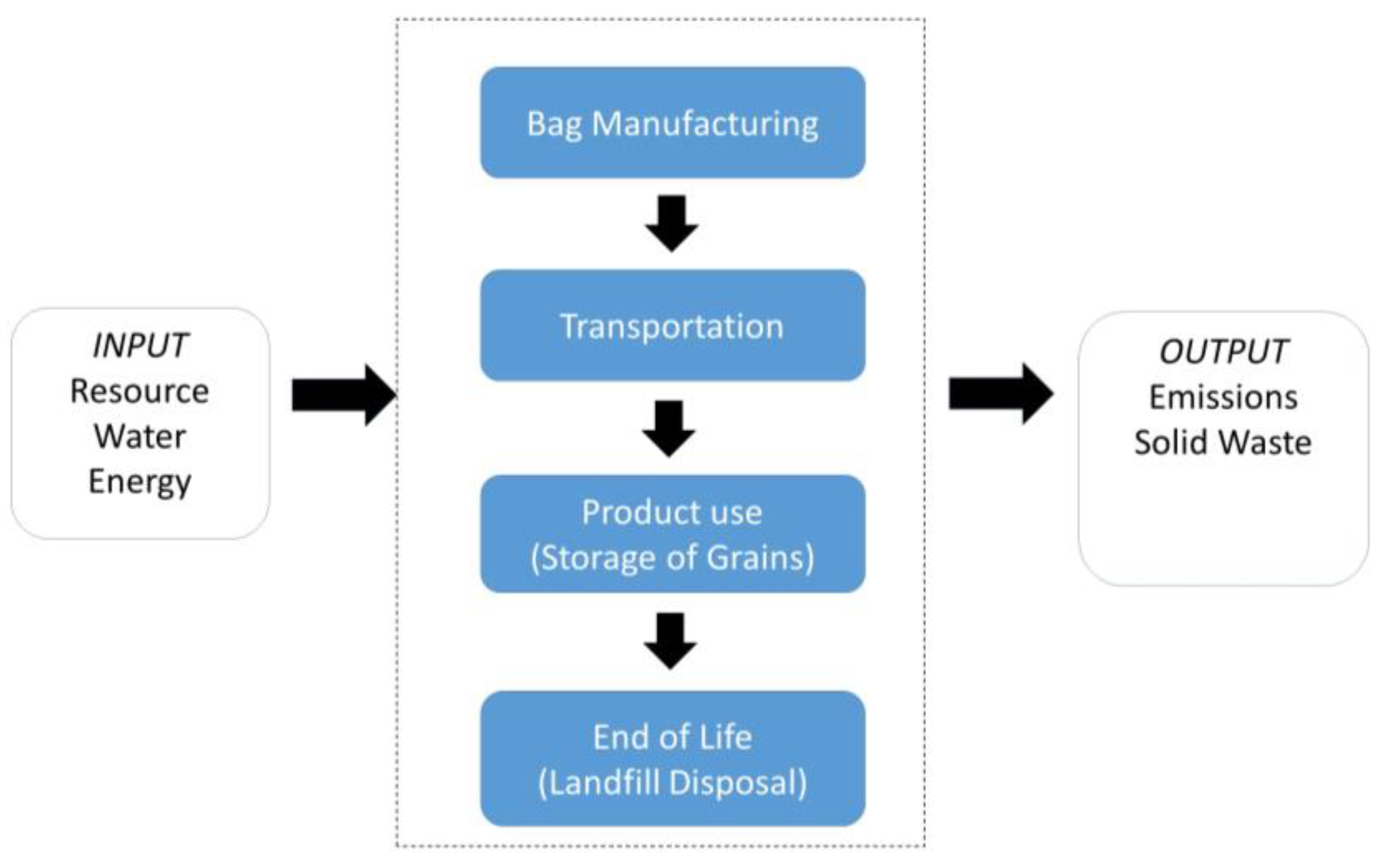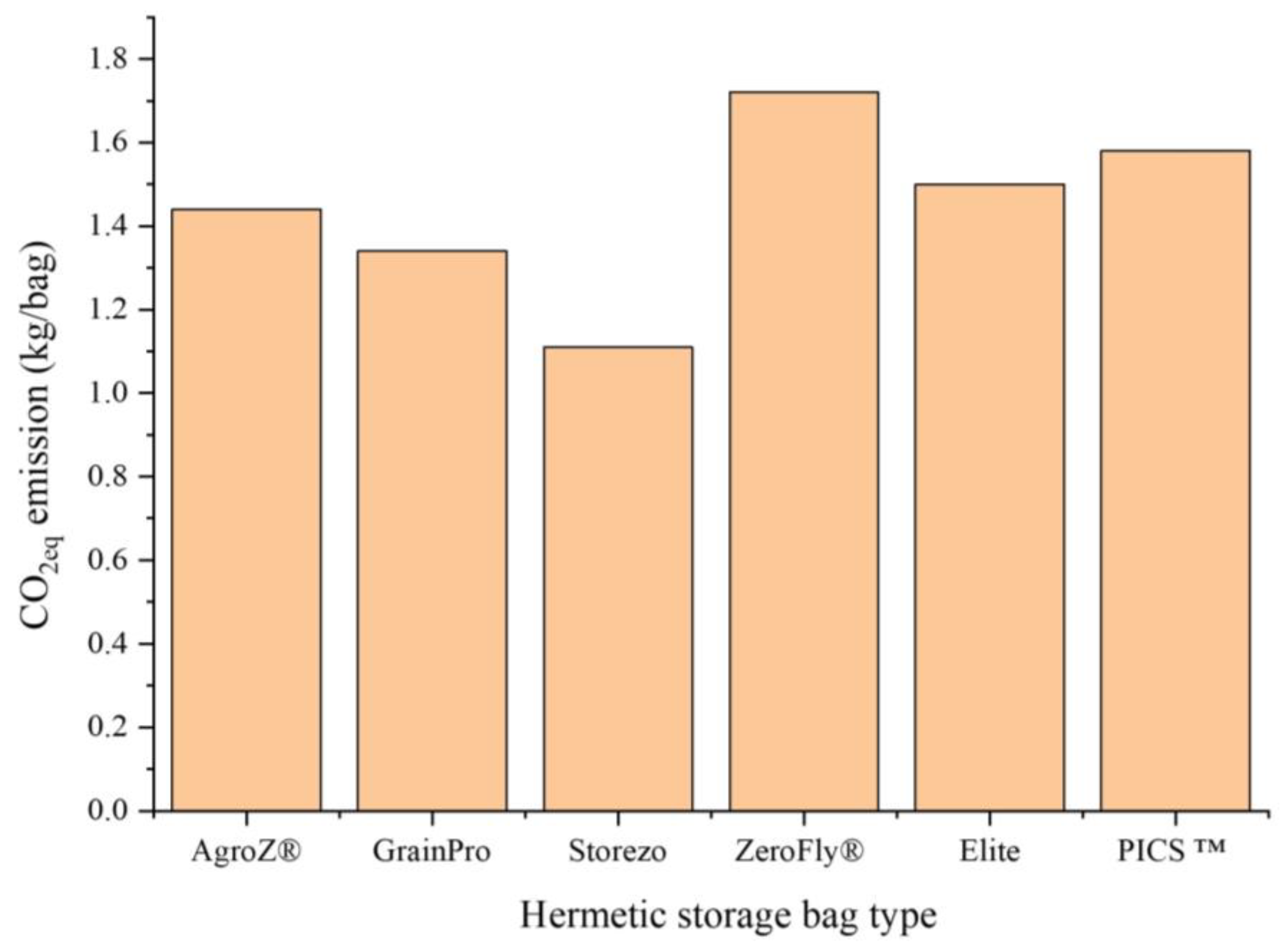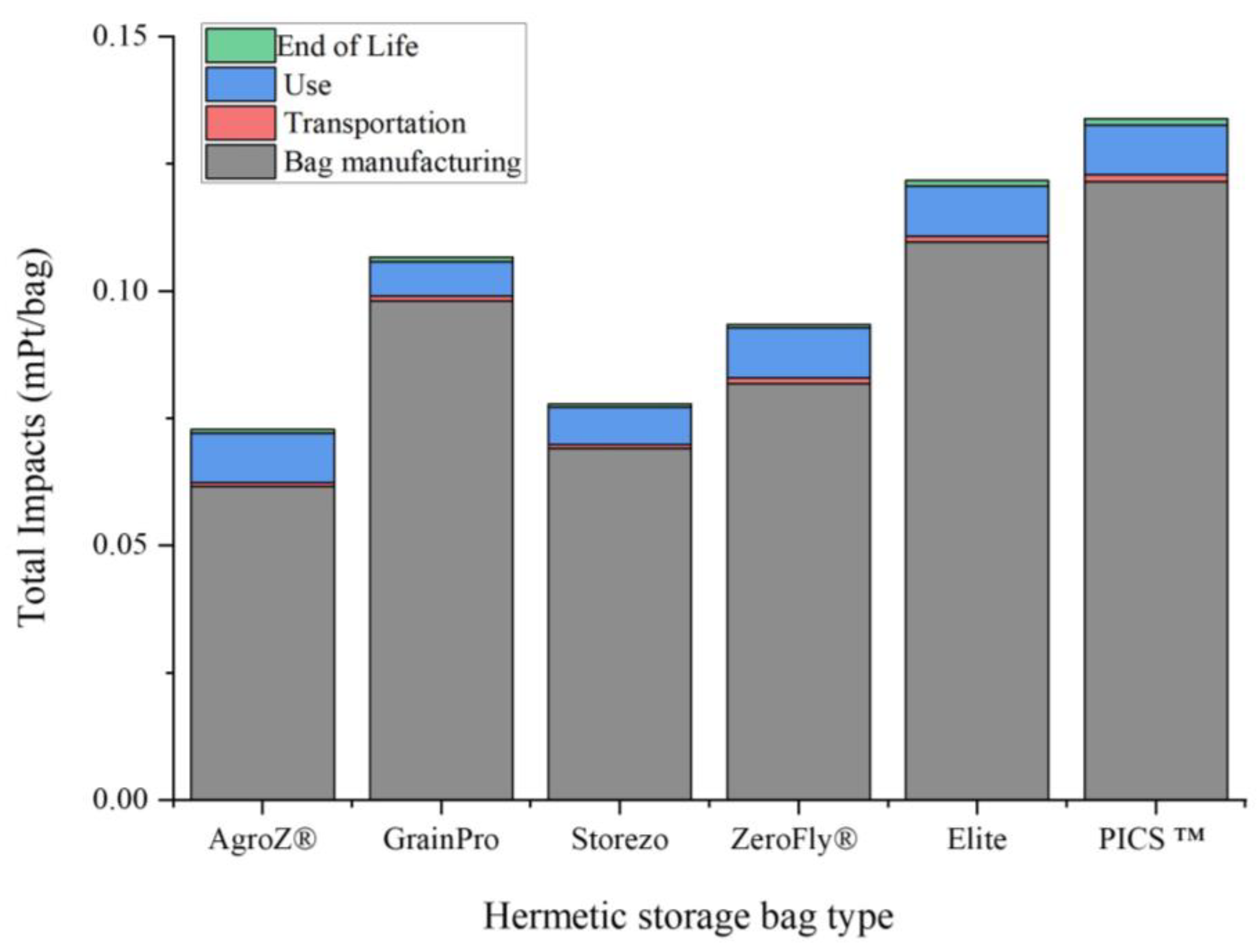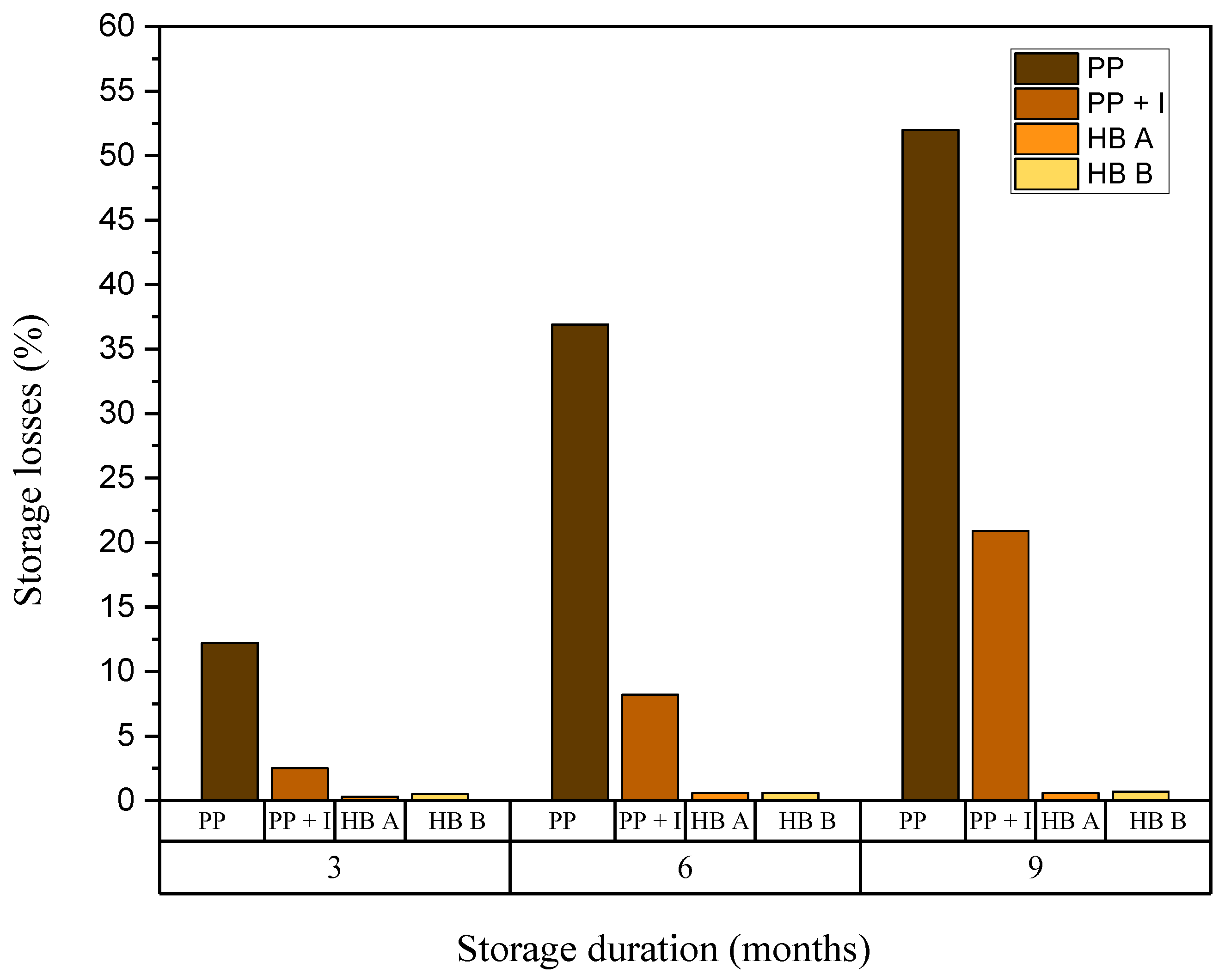Estimating Environmental and Economic Impacts of Hermetic Bag Storage Technology
Abstract
:1. Introduction
2. Materials and Methods
2.1. Life Cycle Assessment (LCA)
2.1.1. Goal and Scope Definition
2.1.2. Functional Unit (FU)
2.1.3. Polymer Composition of Gas Barrier Liners
2.1.4. Impact Categories
2.1.5. Life Cycle Impact Assessment
2.1.6. Sensitivity Analysis
2.2. Techno-Economic Analysis (TEA)
2.2.1. Description of the Analysis
2.2.2. Method of Data Collection
2.2.3. Analytical Approach
3. Results and Discussions
3.1. Life Cycle Assessment (LCA)
3.1.1. Polymer Composition of Gas Barrier Liners
3.1.2. Ecotoxicity, Fossil Fuel Depletion, Greenhouse Gas Emission, and Carbon Footprint
3.1.3. Impacts of the Life Cycle Stage
3.2. Techno-Economic Analysis (TEA)
4. Conclusions
- The confocal and Raman spectroscopy results found differences in the polymer composition of six commercially available gas barrier liners, confirming that AgroZ®, GrainPro, Storezo, and ZeroFly® use coextruded films with an oxygen barrier layer, while PICS™ and Elite bags use liners made solely of polyethylene.
- The life cycle assessment (LCA) of six commercially available hermetic bags from cradle to grave found that the bag manufacturing stage had the highest (84.6% to 90.8%) environmental impact contribution among all the life cycle stages. In terms of environmental impact and carbon footprint for the 27-month service life evaluated for the technology, the key findings include:
- The PICS™ bag had the highest value of 2.6 × 10−2 mPt and 3.3 × 10−2 mPt for ecotoxicity and fossil fuel depletion, respectively.
- The ZeroFly® bag had the highest global warming impact contribution of 2.5 × 10−2 mPt.
- The carbon footprint ranged from 1.1 to 1.7 kg CO2eq per bag.
- The economic analysis of adopting hermetic storage bag technology predicted net profits of 829, 979, and 1130 USD per 10 bags for the crop storage periods of three, six and nine months, which were substantially higher than the initial capital costs of 38, 41, and 45 USD, respectively. Savings from eliminating insecticides and reducing storage losses contributed substantially to the net benefits.
Supplementary Materials
Author Contributions
Funding
Institutional Review Board Statement
Informed Consent Statement
Data Availability Statement
Acknowledgments
Conflicts of Interest
References
- Baributsa, D.; Concepcion Ignacio, M.C. Chapter 6. Developments in the use of hermetic bags for grain storage. In Advances in Post-Harvest Management of Cereals and Grains; Maier, D.E., Ed.; Burleigh Dodds Science Publishing: Cambridge, UK, 2020. [Google Scholar] [CrossRef]
- Manandhar, A.; Milindi, P.; Shah, A. An overview of the post-harvest grain storage practices of smallholder farmers in developing countries. Agriculture 2018, 8, 57. [Google Scholar] [CrossRef]
- Murdock, L.L.; Margam, V.; Baoua, I.; Balfe, S.; Shade, R.E. Death by desiccation: Effects of hermetic storage on cowpea bruchids. J. Stored Prod. Res. 2012, 49, 166–170. [Google Scholar] [CrossRef]
- Murdock, L.L.; Baributsa, D. Hermetic storage for those who need it most-subsistence farmers. In Proceedings of the 11th International Working Conference on Stored Product Protection, Chiang Mai, Thailand, 24–28 November 2014; pp. 24–28. [Google Scholar]
- Navarro, S. Modified Atmospheres for the Control of Stored-Product Insects and Mites. In Insect Management for Food Storage and Processing, 2nd ed.; Heaps, J.W., Ed.; AACC International: St. Paul, MN, USA, 2006; pp. 105–146. Available online: http://ftic.co.il/pdf/2006aNavarro%20Modified%20Atmospheres%20for%20the%20Control%20of%20Stored-Product%20Insects%20and%20Mites.pdf (accessed on 15 November 2018).
- ACDI/VOCA. AflaSTOP Brief: Hermetic Storage: Save Money, Safe Food. 2017. Available online: https://pdf.usaid.gov/pdf_docs/PA00MV4J.pdf (accessed on 21 August 2018).
- Baributsa, D. Empowering the private sector to reduce hunger—PICS Sales crossed 5 million bags per year in 2018. PICS. Newsletter 2019, 5, 1–7. Available online: https://picsnetwork.org/wp-content/uploads/2019/09/Volume-5-E-final-sm.pdf (accessed on 8 January 2020).
- De Groote, H.; Kimenju, S.C.; Likhayo, P.; Kanampiu, F.; Tefera, T.; Hellin, J. Effectiveness of hermetic systems in controlling maize storage pests in Kenya. J. Stored Prod. Res. 2013, 53, 27–36. [Google Scholar] [CrossRef]
- Foy, C.; Wafula, M. Scaling up of Hermetic Bag Technology (PICS) in Kenya: Review of Successful Scaling of Agricultural Technologies. USAID-KAVES. 2016. Available online: https://agrilinks.org/sites/default/files/resource/files/BFS%20Scaling%20Review%20-%20Kenya%20Report%20REVISED%20508%2011-16-16.pdf (accessed on 21 July 2021).
- Govereh, J.; Muchetu, R.G.; Mvumi, B.M.; Chuma, T. Analysis of distribution systems for supply of synthetic grain protectants to maize smallholder farmers in Zimbabwe: Implications for hermetic grain storage bag distribution. J. Stored Prod. Res. 2019, 84, 101–520. [Google Scholar] [CrossRef]
- Moussa, B.; Lowenberg-DeBoer, J.; Fulton, J.; Boys, K. The economic impact of cowpea research in West and Central Africa: A regional impact assessment of improved cowpea storage technologies. J. Stored Prod. Res. 2011, 47, 147–156. [Google Scholar] [CrossRef]
- Moussa, B.; Abdoulaye, T.; Coulibaly, O.; Baributsa, D.; Lowenberg-DeBoer, J. Adoption of on-farm hermetic storage for cowpea in West and Central Africa in 2012. J. Stored Prod. Res. 2014, 58, 77–86. [Google Scholar] [CrossRef]
- AGRA. Economic Assessment of Government Incentives Required for the Promotion of Wide-Scale Utilization and Local Manufacture of Hermetic Storage Technologies; AGRA: Nairobi, Kenya, 2020. [Google Scholar]
- Baributsa, D.; Njoroge, A.W. The use and profitability of hermetic technologies for grain storage among smallholder farmers in eastern Kenya. J. Stored Prod. Res. 2020, 87, 101618. [Google Scholar] [CrossRef]
- Ndegwa, M.K.; De Groote, H.; Gitonga, Z.M.; Bruce, A.Y. Effectiveness and economics of hermetic bags for maize storage: Results of a randomized controlled trial in Kenya. Crop Prot. 2016, 90, 17–26. [Google Scholar] [CrossRef]
- Baributsa, D.; Djibo, K.; Lowenberg-DeBoer, J.; Moussa, B.; Baoua, I. The fate of triple-layer plastic bags used for cowpea storage. J. Stored Prod. Res. 2014, 58, 97–102. [Google Scholar] [CrossRef]
- Hossain, M.A.; Awal, M.A.; Alam, M.M.; Ali, M.R.; Huda, F.A.; Zahan, A. Do hermetic storage technology significantly abate losses of rice over time? An economic evaluation. Int. J. Manag. Account. 2021, 3, 52–59. [Google Scholar] [CrossRef]
- Dijkink, B.; Broeze, J.; Vollebregt, M. Hermetic Bags for the Storage of Maize: Perspectives on Economics, Food Security and Greenhouse Gas Emissions in Different Sub-Saharan African Countries. Front. Sustain. Food Syst. 2022, 6, 767089. [Google Scholar] [CrossRef]
- Geyer, R.; Jambeck, J.R.; Law, K.L. Production, use, and fate of all plastics ever made. Sci. Adv. 2017, 3, 1–5. [Google Scholar] [CrossRef] [PubMed]
- Hamilton, L.A.; Feit, S.; Muffett, C.; Kelso, M.; Rubright, S.M.; Bernhardt, C.; Schaeffer, E.; Moon, D.; Morris, J.; Labbe-Bellas, R. Plastic & Climate: The Hidden Costs of a Plastic Planet. 2019. Available online: www.ciel.org/plasticandclimate (accessed on 6 October 2021).
- Bauman, B. How Plastics Contribute to Climate Change. Climate Connections. 2019. Available online: https://yaleclimateconnections.org/2019/08/how-plastics-contribute-to-climate-change/ (accessed on 5 June 2022).
- Greene, J. Life Cycle Assessment of Reusable and Single-Use Plastic Bags in California; Institute for Sustainable Development, California State University: Chico, CA, USA, 2011. [Google Scholar]
- Mbohwa, C.; Manjera, G. An environmental assessment of the life cycle of the plastic carrier bag in Zimbabwe. Adv. Mater. Res. 2007, 18–19, 501–508. [Google Scholar] [CrossRef]
- Siracusa, V.; Dalla Rosa, M.; Romani, S.; Rocculi, P.; Tylewicz, U. Life cycle assessment of multilayer polymer film used on food packaging field. Procedia Food Sci. 2011, 1, 235–239. [Google Scholar] [CrossRef]
- Muthu, S.S.; Li, Y.; Hu, J.Y.; Mok, P.Y.; Ding, X. Eco-impact of plastic and paper shopping bags. J. Eng. Fibers Fabr. 2012, 7, 26–37. [Google Scholar] [CrossRef]
- Klopffer, W. Life cycle assessment: From beginning to the current state. Environ. Sci. Pollut. Res. 1997, 4, 223–228. [Google Scholar] [CrossRef]
- International Organization for Standardization. Environmental Management-Life Cycle Assessment-Principles and Framework; International Standard Organization: Geneva, Switzerland, 2006. [Google Scholar]
- Alhazmi, H.; Almansour, F.H.; Aldhafeeri, Z. Plastic waste management: A review of existing life cycle assessment studies. Sustainability 2021, 13, 5340. [Google Scholar] [CrossRef]
- Zhang, C.; Rosentrater, K.A. Estimating economic and environmental impacts of red-wine-making processes in the USA. Fermentation 2019, 5, 77. [Google Scholar] [CrossRef]
- Matlock, M.; Pfister, S.; Ridoutt, B.; Rosentrater, K.; Thoma, G.; Yao, Y. Goals, strengths, and limitations governing the use of life cycle assessment in food and agriculture. CAST Comment. 2022, 1, 1–20. Available online: https://www.cast-science.org/publication/goals-strengths-and-limitations-governing-the-use-of-life-cycle-assessment-lca-in-food-and-agriculture/ (accessed on 23 January 2023).
- Blengini, G.A.; Busto, M. The life cycle of rice: LCA of alternative agri-food chain management systems in Vercelli (Italy). J. Environ. Manag. 2009, 90, 1512–1522. [Google Scholar] [CrossRef] [PubMed]
- Suleiman, R.A.; Rosentrater, K.A. Techno-economic analysis (TEA) and life cycle assessment (LCA) of maize storage in developing countries. Agric. Eng. Int. CGIR J. 2019, 21, 135–142. Available online: https://dr.lib.iastate.edu/server/api/core/bitstreams/b95d18a9-3a56-412d-b857-d93e84eec58a/content (accessed on 3 August 2022).
- Niggli, U.A.; Fließbach, P. Hepperly, and N. Scialabba. Low greenhouse gas agriculture: Mitigation and adaptation potential of sustainable farming systems. Okol. Landbau 2009, 141, 32–33. Available online: https://orgprints.org/id/eprint/15690/1/niggli-etal-2009-lowgreenhouse.pdf (accessed on 8 August 2022).
- Li, H.; Qiu, J.; Wang, L.; Tang, H.; Li, C.; Van Ranst, E. Modelling impacts of alternative farming management practices on greenhouse gas emissions from a winter wheat–maize rotation system in China. Agric. Ecosyst. Environ. 2010, 135, 24–33. [Google Scholar] [CrossRef]
- Chai, S.Y.W.; Phang, F.J.F.; Yeo, L.S.; Ngu, L.H.; How, B.S. Future era of techno-economic analysis: Insights from review. Front. Sustain. 2022, 3, 924047. [Google Scholar] [CrossRef]
- Canette, A.; Briandet, R. Confocal laser scanning microscopy. Encycl. Food Microbiol. 2014, 2, 1389–1396. [Google Scholar] [CrossRef]
- Elliot, A.D. Confocal microscopy: Principles and modern practices. Curr. Protoc. Cytom. 2020, 92, e68. [Google Scholar] [CrossRef] [PubMed]
- Gaston, F.; Dupuy, N.; Marque, S.R.A.; Dorey, S. Evaluation of multilayer film stability by Raman spectroscopy after gamma-irradiation sterilization process. Vib. Spectrosc. 2018, 96, 52–59. [Google Scholar] [CrossRef]
- Furukawa, T.; Sato, H.; Kita, Y.; Matsukawa, K.; Yamaguchi, H.; Ochiai, S.; Siesler, H.W.; Ozaki, Y. Molecular structure, crystallinity and morphology of polyethylene/propylene blends studied by raman mapping, scanning electron microscopy, wide angle x-ray diffraction, and differential scanning calorimetry. Polym. J. 2006, 38, 1127–1136. [Google Scholar] [CrossRef]
- Sustainable Minds v4.0. Available online: https://app.sustainableminds.com/ (accessed on 1 January 2021).
- Huang, H.; Danao, M.C.; Rausch, K.D.; Singh, V. Diffusion and production of carbon dioxide in bulk corn at various temperatures and moisture contents. J. Stored Prod. Res. 2013, 55, 21–26. [Google Scholar] [CrossRef]
- Bern, C.J.; Steele, J.L.; Vance Morey, R. Shelled corn CO2 evolution and storage time for 0.5% dry matter loss. Agriculture 2002, 18, 703–706. [Google Scholar] [CrossRef]
- Interest Rates Africa. Available online: https://tradingeconomics.com/country-list/interest-rate?continent=africa (accessed on 15 November 2022).
- Mutambuki, K.; Likhayo, P. Efficacy of different hermetic bag storage technologies against insect pests and aflatoxin incidence in stored maize grain. Bull. Entomol. Res. 2021, 111, 499–510. [Google Scholar] [CrossRef] [PubMed]
- Postharvest Loss Reduction Centre at Natural Resources Institute. GrainPro SuperGrainbag and PICS Triple Bags. University of Greenwich. Available online: https://postharvest.nri.org/loss-reduction/choosing-the-right-grain-store/storage-search/91-triplebags (accessed on 1 October 2022).
- Ng’ang’a, J.; Mutungi, C.; Imathiu, S.M.; Affognon, H. Low permeability triple-layer plastic bags prevent losses of maize caused by insects in rural on-farm stores. Food Sec. 2016, 8, 621–633. [Google Scholar] [CrossRef]
- O’neill, A. Inflation Rate in Sub-Saharan Africa. 2027. Available online: https://www.statista.com/statistics/805570/inflation-rate-in-sub-saharan-africa/ (accessed on 1 November 2022).
- Alemu, G.T.; Nigussie, Z.; Haregeweyn, N.; Berhanie, Z.; Wondimagegnehu, B.A.; Ayalew, Z.; Molla, D.; Okoyo, E.N.; Baribusta, D. Cost-benefit analysis of on-form grain storage hermetic bags among small-scale maize growers in northwestern Ethiopia. Crop Prot. 2021, 143, 105478. [Google Scholar] [CrossRef]
- Palmer, J.; Herat, S. Ecotoxicity of Microplastic Pollutants to Marine Organisms: A Systematic Review. Water Air Soil Pollut. 2021, 232, 195. [Google Scholar] [CrossRef]
- Popa, E.E.; Geicu-Cristea, M.; Popescu, P.A.; Mitelut, A.C.; Draghici, M.C.; Danaila-Guidea, S.M.; Popa, M.E. Methods used for ecotoxicity assessment of polymeric packaging materials. Scientific Papers. Series A. Agronomy 2022, 65, 691–696. Available online: https://www.researchgate.net/publication/364324866_Methods_used_for_ecotoxicity_assessment_of_polymeric_packaging_materials (accessed on 18 January 2023).
- Harding, K.G.; Dennis, J.S.; von Blottnitz, H.; Harrison, S.T.L. Environmental analysis of plastic production processes: Comparing petroleum-based polypropylene and polyethylene with biologically based poly-β-hydroxybutyric acid using life cycle analysis. J. Biotechnol. 2007, 130, 57–66. [Google Scholar] [CrossRef] [PubMed]
- Kilgore, G. Carbon Footprint of Polyester vs. Cotton vs. Wool vs. Leather vs. Nylon (Calculator). BillionTress.com. 2023. Available online: https://8billiontrees.com/carbon-offsets-credits/carbon-footprint-of-polyester/#:~:text=The%20carbon%20footprint%20of%20nylon,CO2eq%20per%20kg (accessed on 21 March 2023).
- CarbonCloud. Available online: www.carboncloud.com (accessed on 21 March 2023).
- Posen, D.; Jaramillo, P.; Landis, A.; Griffin, W.M. Greenhouse gas mitigation for U.S. plastics production: Energy first, feedstocks later. Environ. Res. Lett. 2017, 12, 034024. [Google Scholar] [CrossRef]
- Bellanger, M. This Startup Is Leading the Fight against Food Loss and Waste in Madagascar. 2021. Available online: https://www.one.org/international/blog/food-loss-waste-madagascar/ (accessed on 3 January 2023).
- Baributsa, D.; Baoua, I.; Djibo, K.; Murdock, L. Using and Recycling Purdue Improved Crop Storage (PICS) Bags. Purdue Extension. The Education Store. 2015. Available online: www.the-education-store.com (accessed on 17 September 2019).
- Channa, H.; Chen, A.Z.; Pina, P.; Ricker-Gilbert, J.; Stein, D. What drives smallholder framers’ willingness to pay for a new farm technology? Evidence from an experimental auction in Kenya. Food Policy 2019, 85, 64–71. [Google Scholar] [CrossRef] [PubMed]
- Darfour, B.; Rosentrater, K.A. Cost assessment of five different maize grain handling techniques to reduce postharvest losses from insect contamination. Insects 2020, 1, 50. [Google Scholar] [CrossRef]
- Jones, M.; Alexander, C.; Lowenberg-Deboer, J. A simple methodology for measuring profitability of on-farm storage pest management in developing countries. J. Stored Prod. Res. 2014, 58, 67–76. [Google Scholar] [CrossRef]
- Jones, M.S.; Alexander, C.E.; Smith, B. Economic consequences of post-harvest insect damage in Rwandan common bean markets. Crop Prot. 2018, 104, 92–100. [Google Scholar] [CrossRef]
- Bare, J. Tool for the Reduction and Assessment of Chemical and Other Environmental Impacts (TRACI) TRACI Version 2.1 User’s Guide; US EPA Office of Research and Development: Washington, DC, USA, 2014; RPA/600/R-12/554. [Google Scholar]
- Morten, R.; Vieira, M.D.M.; Zgola, M.; Bare, J.; Rosenbaum, R.K. Updated US and Canadian normalization factors for TRACI 2.1. Clean Technol. Environ. Policy 2014, 16, 1–11. [Google Scholar]
- Gloria, T.P.; Lippiatt, B.C.; Cooper, J. Life cycle impact assessment weights to support environmentally preferable purchasing in the United States. Environ. Sci. Technol. 2007, 121, 7551–7557. [Google Scholar] [CrossRef] [PubMed]
- Cecon, V.S.; Curtzwiler, G.W.; Vorst, K.L. A study on recycled polymers recovered from multilayer plastic packaging films by solvent targeted recovery and precipitation (STRAP). Macromol. Mater. Eng. 2022, 307, 2200346. [Google Scholar] [CrossRef]








| Hermetic Storage Bag Brand | Components | Material | Capacity | Length | Width | Weight |
|---|---|---|---|---|---|---|
| kg | cm | cm | g | |||
| AgroZ® | outer bag | woven polypropylene | 100 | 120 | 80 | 100 |
| inner liner bag | multilayer liner | 130 | 75 | 150 | ||
| GrainPro | outer bag | woven polypropylene | 69 | 120 | 80 | 100 |
| inner liner bag | multilayer liner | 110 | 70 | 150 | ||
| Storezo | outer bag | woven polypropylene | 75 | 120 | 80 | 100 |
| inner liner bag | multilayer liner | 130 | 75 | 150 | ||
| ZeroFly® | outer bag | woven polypropylene | 100 | 125 | 80 | 100 |
| inner liner bag | multilayer liner | 130 | 70 | 150 | ||
| Elite | outer bag | woven polypropylene | 105 | 120 | 75 | 150 |
| inner liner bag | 2 HDPE liners | 130 | 74 | 250 | ||
| PICS™ | outer bag | woven polypropylene | 100 | 137 | 75 | 100 |
| inner liner bag | 2 HDPE liners | 137 | 70 | 300 |
| Categories | Description |
|---|---|
| Ecotoxicity | Ecosystem impacts of the emission of toxic substances into air, water, and soil can occur on global, continental, or local scales; the plastic industry contributes to the toxicity caused by the emissions of toxic substances [28]. |
| Fossil Fuel Depletion | The extraction of natural gas, oil, and coal reserves at a rate higher than nature replenishes them. Feedstock in manufacturing of plastics [40]. |
| Global Warming | Increasing temperature in the lower atmosphere, caused by the emission of greenhouse gases (e.g., CO2, methane, and nitrous oxides), which reflect or absorb infrared radiation from the Earth’s surface. This causes regional climate changes, the melting of polar ice and glaciers, and sea-level rise [28]. |
| Inventory | AgroZ® | GrainPro | Storezo | ZeroFly® | Elite | PICS ™ |
|---|---|---|---|---|---|---|
| Energy (kJ/bag) | 33 | 33 | 33 | 33 | 25 | 25 |
| Water (L/bag) | 102 | 102 | 102 | 102 | 76 | 76 |
| Life Cycle Stage | Description |
|---|---|
| Bag manufacturing | Extrusion process (film) using virgin polymer resin |
| Transportation | Transport, combination truck, average fuel mix (350 km) |
| Use | Respiration rate of dry corn (MC < 14%) 0.34 mg CO2/(kg·h) [41] was used to calculate the carbon dioxide produced by maize during storage. Carbon dioxide as by-product of respiration is an indicator of maize deterioration during storage [42]. Assumption: All CO2 produced by maize during storage is released to the environment after opening the bag. |
| End of life | Landfill disposal (transport to landfill was not considered) |
| Total Service Delivered (Storage Season) * | Bag Material (Weight) |
|---|---|
| ±2 | 80% Biopolymer barrier liner (PLA/PE) (250 g) |
| Coextruded barrier liner (150 g) | |
| PE gas barrier liner (250 g) | |
| PP bag (150 g) | |
| Jute sack (900 g) |
| Assumptions | Value | Remarks/References | ||
|---|---|---|---|---|
| Storage bag method | ||||
| Polypropylene bag (PP) PP bag + insecticide (PP + I) Hermetic bag type A (HB A) Hermetic bag type B (HB B) | ||||
| Storage duration (months) per season | 3 | 6 | 9 | |
| Service life (months) for 3 seasons | 9 | 18 | 27 | |
| Interest rate, per annum | 0.2 | 0.2 | 0.2 | [43] |
| Bag cost (USD/bag − 100 kg capacity) | [44] | |||
| Polypropylene bag | 0.5 | |||
| Hermetic bag A | 4.0 | |||
| Hermetic bag B | 3.0 | |||
| Insecticides, USD/bag (reapply every 3 months) | 1.2 | 1.2 | 1.2 | [17,45] |
| Adoption cost | ||||
| Bagging labor (USD/bag) | 0.5 | 0.5 | 0.5 | [9] |
| Insecticide application (USD/bag) | 1 | 1 | 1 | [9] |
| Transportation | ||||
| PP bag, USD/bag | 0.80 | 0.65 | 0.5 | [46] |
| Hermetic bag, USD/bag | 0.36 | 0.21 | 0.06 | [46] |
| Discounts due to damage, % | ||||
| 10–20% damaged: 8% >20% damaged: 16% | [20] | |||
| Damaged grain, % | ||||
| PP bag | 18 | 35 | 50 | [20,45,46] |
| PP bag + insecticide | <5 | <6 | 10 to 20 | |
| Hermetic bag A | <5 | <5 | <10 | |
| Hermetic bag B | 3.5 | 3.5 | 4 | |
| Loss Sales (weight loss, %) | ||||
| PP bag | 4.2 | 20.9 | 36 | [20,45] |
| PP bag + insecticide | 2.5 | 8.2 | 12.9 | |
| Hermetic bag A | 0.3 | 0.6 | 1.0 | [45] |
| Hermetic bag B | 0.5 | 0.7 | 1.0 | |
| Market prices, USD/kg | 0.30 | 0.35 | 0.40 | [20,45] |
| All Bags Lifetime, year | 3 | [20,45] | ||
| Analyses (Units Included) | Equations (Units Included) |
|---|---|
| Storage duration (SD), (months/season) |
|
| Total service life (TSL), (months/bag) |
|
| Total storage bag capacity (TSC), (kg/total service life) |
|
| Annuity (A), USD |
|
| Capital cost (CC), USD |
|
| Bagging cost (BC), (USD/total service life) |
|
| Insecticides and application cost (IC), (USD/total service life) |
|
| Transportation cost (TrC), (USD/total service life) |
|
| Total operational cost (TOC), (USD/total service life) |
|
| Total cost (TC), (USD/total service life) |
|
| Discount due to grain damage (DGD), (USD/total service life) |
|
| Loss of sales (LOS), (USD/total service life) |
|
| Total benefits (TB), (USD/total service life) |
|
| Profit (P), (USD/total service life) |
|
| Storage loss (SL), (%) |
|
| Hermetic Storage Bag Type | Number of Layer (s) | Composition | Total Thickness, μm | Layer Thickness, μm | ||
|---|---|---|---|---|---|---|
| 1st | 2nd | 3rd | ||||
| AgroZ® | 3 | PE-Nylon-PE | 82.5 ± 1.2 | 50.1 ± 2.6 | 8.9 ± 0.6 | 23.5 ± 3.2 |
| GrainPro | 3 | PE-Nylon-PE | 81.8 ± 1.0 | 37.2 ± 0.3 | 9.1 ± 0.9 | 35.5 ± 0.9 |
| Storezo | 3 | PE-EvOH-PE | 79.8 ± 1.8 | 34.4 ± 0.2 | 10.2 ± 0.9 | 35.7 ± 0.9 |
| ZeroFly® | 4 | PE-PP-Nylon | 80.0 ± 0.8 | 39.1 ± 0.9 | 11.1 ± 0.2 | 29.7 ± 0.4 |
| Elite | 1 | PE | 74.5 ± 0.5 | |||
| PICS ™ | 1 | PE | 75.5 ± 0.4 | |||
| Life Stages | Average Total Impacts (%) | ||
|---|---|---|---|
| Current (3 Seasons) | −2 Seasons | +2 Seasons | |
| Bag manufacturing | 88.96 | 94.41 | 82.48 |
| Transportation | 1.02 | 0.96 | 0.84 |
| Use | 9.19 | 3.66 | 15.92 |
| End of life | 0.84 | 0.96 | 0.76 |
| Total impacts (mPt/bag) | 0.10 | 0.09 | 0.11 |
| Bag Type | kg CO2eq/bag | Total Impacts (mPt/bag) | Bag Manufacturing (% of Total mPt) |
|---|---|---|---|
| 80% Biopolymer barrier liner (PLA/PE) | 1.7 | 0.09 | 86.9 |
| Coextruded barrier liner | 1.1 | 0.05 | 79.7 |
| PE gas barrier liner | 1.2 | 0.08 | 85.9 |
| PP bag | 1.1 | 0.03 | 69.2 |
| Jute sack | 4.9 | 0.36 | 96.4 |
| 3-Month Storage | 6-Month Storage | 9-Month Storage | |
|---|---|---|---|
| Capital cost (USD) | 38 | 41 | 45 |
| Savings for not buying insecticide (USD) | 89 | 163 | 163 |
| Savings for storage loss reduction (USD) | 106 | 381 | 616 |
| Profit per 10 bags (USD) | 829 | 979 | 1130 |
Disclaimer/Publisher’s Note: The statements, opinions and data contained in all publications are solely those of the individual author(s) and contributor(s) and not of MDPI and/or the editor(s). MDPI and/or the editor(s) disclaim responsibility for any injury to people or property resulting from any ideas, methods, instructions or products referred to in the content. |
© 2023 by the authors. Licensee MDPI, Basel, Switzerland. This article is an open access article distributed under the terms and conditions of the Creative Commons Attribution (CC BY) license (https://creativecommons.org/licenses/by/4.0/).
Share and Cite
Ignacio, M.C.C.D.; Rosentrater, K.A.; Maier, D.E. Estimating Environmental and Economic Impacts of Hermetic Bag Storage Technology. Sustainability 2023, 15, 14850. https://doi.org/10.3390/su152014850
Ignacio MCCD, Rosentrater KA, Maier DE. Estimating Environmental and Economic Impacts of Hermetic Bag Storage Technology. Sustainability. 2023; 15(20):14850. https://doi.org/10.3390/su152014850
Chicago/Turabian StyleIgnacio, Ma. Cristine Concepcion D., Kurt A. Rosentrater, and Dirk E. Maier. 2023. "Estimating Environmental and Economic Impacts of Hermetic Bag Storage Technology" Sustainability 15, no. 20: 14850. https://doi.org/10.3390/su152014850
APA StyleIgnacio, M. C. C. D., Rosentrater, K. A., & Maier, D. E. (2023). Estimating Environmental and Economic Impacts of Hermetic Bag Storage Technology. Sustainability, 15(20), 14850. https://doi.org/10.3390/su152014850







